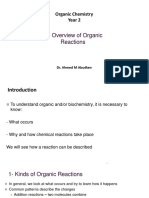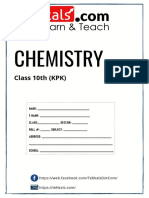Chapter 6 An Overview of Organic Reactions
Uploaded by
Ren Liew Jia QingChapter 6 An Overview of Organic Reactions
Uploaded by
Ren Liew Jia Qing2/28/2011
John E. McMurry
http://www.cengage.com/chemistry/mcmurry
Chapter 6 An Overview of Organic Reactions
CHP 6 Problems: 6.1-13, 17-36.
Richard Morrison University of Georgia, Athens
Organic Chemical Reactions
Organic chemical reactions broadly organized in two ways:
1.
What kinds of reactions occur
2.
How those reactions occur
6.1 Kinds of Organic Reactions
Addition reactions Occur when two reactants add together to form a single product with no atoms left over Reaction of fumarate with water to yield malate (a step in the citric acid cycle of food metabolism)
2/28/2011
Kinds of Organic Reactions
Elimination reactions Occur when a single reactant splits into two products (usually with the formation of a small molecule such as water) Reaction of hydroxybutyryl ACP to yield trans-crotonyl ACP and water (a step in the biosynthesis of fat molecules)
Kinds of Organic Reactions
Substitution reactions Occur when two reactants exchange parts to give two new products Reaction of an ester such as methyl acetate with water to yield a carboxylic acid and an alcohol
In biological pathways this type of reaction occurs in the
metabolism of dietary fats
Kinds of Organic Reactions
Rearrangement reactions Occur when a single reactant undergoes a reorganization of bonds and atoms to yield an isomeric product Rearrangement of dihydroxyacetone phosphate into its constitutional isomer glyceraldehyde 3-phosphate (a step in the metabolism of carbohydrates)
2/28/2011
6.2 How Organic Reactions Occur: Mechanisms
Reaction Mechanism An overall description of how a reaction occurs at each stage of a chemical transformation Which bonds are broken and in what order Which bonds are formed and in what order What is the relative rate of each step A complete mechanism accounts for all reactants consumed and all products formed
How Organic Reactions Occur: Mechanisms
All chemical reactions involve bond breaking and bond making
Two ways a covalent two-electron bond can break:
1.
2.
Symmetrical One electron remains with each product fragment Unsymmetrical Both bonding electrons remain with one product fragment, leaving the other with a vacant orbital
Half-headed arrow, fishhook, indicates movement of one electron
Full-headed arrow indicates movement of two electrons
How Organic Reactions Occur: Mechanisms
Two ways a covalent two-electron bond can form:
1.
Symmetrical
One electron is donated to the new bond by each reactant (radical)
2.
Unsymmetrical
Both bonding electrons are donated by one reactant (polar)
2/28/2011
How Organic Reactions Occur: Mechanisms
Radical reaction Process that involves symmetrical bond breaking and bond making Radical (free radical) A neutral chemical species that contains an odd number of electrons and has a single, unpaired electron in one of its orbitals Polar reactions Process that involves unsymmetrical bond breaking and bond making Involve species that have an even number of electrons (have only electron pairs in their orbitals) Common in both organic and biological chemistry
6.3 Radical Reactions
Radical Highly reactive because it contains an atom with an odd number of electrons (usually seven) in a valence shell Can achieve a valence shell octet through:
Radical substitution reaction Radical abstracts an atom and one bonding electron from another reactant
Radical Reactions
Radical addition reaction A reactant radical adds to a double bond, taking one electron from double bond and leaving one behind to form a new radical
2/28/2011
Radical Reactions
Industrial radical reaction The chlorination of methane to yield chloromethane A substitution reaction First step in the preparation of the solvents dichloromethane (CH2Cl2) and chloroform (CHCl3)
Radical Reactions
Radical chlorination of methane requires three kinds of steps: initiation, propagation, and termination
1.
Initiation
Ultraviolet light breaks Cl-Cl bond to generate chlorine radicals
Radical Reactions
2.
Propagation
Reaction with CH4 to generate new radicals and propagate the chain reaction
2/28/2011
Radical Reactions
3.
Termination
Two radicals combine to end the chain reaction No new radical species is formed
Radical Reactions
Biological radical reaction Prostaglandin synthesis initiated by abstraction of a
hydrogen atom from arachidonic acid.
Radical Reactions
The carbon radical reacts with O2 to give an oxygen radical Oxygen radical reacts with C=C bond (several steps) Prostaglandin H2 produced
2/28/2011
6.4 Polar Reactions
Polar reactions Occur because of electrical attraction between positive and negative centers on functional groups in molecules Most organic compounds are electrically neutral, they have no net charge Bond polarity Certain bonds within a molecule are polar
Consequence of an unsymmetrical electron distribution in a bond Due to the difference in electronegativity of the bonded atoms.
Polar Reactions
Certain bonds within molecules, particularly those in functional groups, are polar
Oxygen, nitrogen, fluorine, and chlorine are more
electronegative than carbon
Carbon is always positively polarized (
) when bonded to
more electronegative elements Carbon is negatively polarized (
) when bonded to metals
Polar Reactions
2/28/2011
Polar Reactions
Polar Reactions
Polar bonds
Can also result from interactions of functional groups with acids or bases Methanol
In neutral methanol the carbon atom is somewhat electron-poor Protonation of the methanol oxygen by an acid makes carbon much more electron-poor
Polar Reactions
Polarizability of the atom
The measure of change in electron distribution around the atom to an external electrical influence Larger atoms (more, loosely held electrons) more polarizable Smaller atoms (fewer, tightly held electrons) less polarizable Although carbon-sulfur and carbon-iodine bonds are nonpolar according to electronegativity values, they usually react as if they are polar because sulfur and iodine are highly polarizable
Effects of polarizability on bonds
2/28/2011
Polar Reactions
Electron-rich sites react with electron-poor sites Bonds made when electron-rich atom donates a pair of electrons to an electron-poor atom Bonds broken when one atom leaves with both electrons from the former bond A curved arrow shows electron movement Electron pair moves from the atom (or bond) at tail of arrow to atom at head of arrow during reaction
Polar Reactions
Nucleophile
Substance that is nucleus -loving Has a negatively polarized electron-rich atom Can form a bond by donating a pair of electrons to a
positively polarized, electron-poor atom
May be either neutral or negatively charged
Electrophile
Substance that is electron -loving Has a positively polarized, electron-poor atom Can form a bond by accepting a pair of electrons from a
nucleophile
May be either neutral or positively charged
Polar Reactions
Electrostatic potential maps identify: Nucleophilic atoms (red; negative) Electrophilic atoms (blue; positive)
2/28/2011
Polar Reactions
Neutral Compounds React either as nucleophiles or electrophiles (depending on circumstances) Water Nucleophile when it donates a nonbonding pair of electrons Electrophile when it donates H+ Carbonyl compound Nucleophile when it reacts at its negatively polarized oxygen atom Electrophile when it reacts at its positively polarized carbon atom A compound that is neutral but has as electron-rich nucleophilic site must also have a corresponding electron-poor electrophilic site
Polar Reactions
Nucleophiles and Electrophiles
Similar to Lewis acids and Lewis bases Lewis bases Electron donor Behave as nucleophiles Lewis acids Electron acceptors Behave as electrophiles Terms nucleophile and electrophile used primarily when bonds to carbon are involved
Worked Example 6.1
Identifying Electrophiles and Nucleophiles
Which of the following species is likely to behave as a nucleophile and which as an electrophile?
(a) (CH3)3S+ (b)
CN
(c) CH3NH2
10
You might also like
- DENT1002-Lecture6-Overview of Organic Reactions-BDoganNo ratings yetDENT1002-Lecture6-Overview of Organic Reactions-BDogan34 pages
- chapter III Functional Groups – Organic reactionsNo ratings yetchapter III Functional Groups – Organic reactions82 pages
- ATOOCV1 3 0 Reaction Mechanism Structure and ReactivityNo ratings yetATOOCV1 3 0 Reaction Mechanism Structure and Reactivity38 pages
- Module 7 Overview of Organic Reactions Rev 10192023No ratings yetModule 7 Overview of Organic Reactions Rev 1019202318 pages
- CM1002/BS1013: Foundations of Chemistry II: An Overview of Organic ReactionsNo ratings yetCM1002/BS1013: Foundations of Chemistry II: An Overview of Organic Reactions18 pages
- 4bis. An Overview of Organic Reactions: Based On Mcmurry'S Organic Chemistry, 6 Edition, Chapter 5No ratings yet4bis. An Overview of Organic Reactions: Based On Mcmurry'S Organic Chemistry, 6 Edition, Chapter 520 pages
- Topic 1 - Introduction Learning Objectives:: Module 1 - Organic ChemistryNo ratings yetTopic 1 - Introduction Learning Objectives:: Module 1 - Organic Chemistry8 pages
- Chapter 3 An Overview of Organic ReactionsNo ratings yetChapter 3 An Overview of Organic Reactions24 pages
- ATOOCV1 3 0 Reaction Mechanism Structure and ReactivityNo ratings yetATOOCV1 3 0 Reaction Mechanism Structure and Reactivity76 pages
- The University of Zambia School of Natural Sciences: Chemistry DepartmentNo ratings yetThe University of Zambia School of Natural Sciences: Chemistry Department48 pages
- Lecture 9 - 10 CHE202 Overview of Organic ReactionNo ratings yetLecture 9 - 10 CHE202 Overview of Organic Reaction33 pages
- Reagen T and Reactio N Mecha Nisms: Physic Organic ChemistryNo ratings yetReagen T and Reactio N Mecha Nisms: Physic Organic Chemistry34 pages
- An Overview of Organic Reactions: Based On Mcmurry'S Organic Chemistry, 6 Edition, Chapter 5 ©2003No ratings yetAn Overview of Organic Reactions: Based On Mcmurry'S Organic Chemistry, 6 Edition, Chapter 5 ©200335 pages
- Toaz - Info S N Sanyal Reactions Rearrangements and Reagents Organic Chemistry For Iit Jee N PRNo ratings yetToaz - Info S N Sanyal Reactions Rearrangements and Reagents Organic Chemistry For Iit Jee N PR277 pages
- Chapter 3 - Overview of Mechanisms 2022No ratings yetChapter 3 - Overview of Mechanisms 202243 pages
- Chapter 2: Introduction To Organic Reaction: Opposite Charges AttractNo ratings yetChapter 2: Introduction To Organic Reaction: Opposite Charges Attract29 pages
- GOC tricks and tips for easy memorizationNo ratings yetGOC tricks and tips for easy memorization10 pages
- Reactions, Rearrangements and Reagents (PDFDrive)100% (1)Reactions, Rearrangements and Reagents (PDFDrive)276 pages
- Unit VII - Org. Reac. Syn. Drug - Total Notes - SMNo ratings yetUnit VII - Org. Reac. Syn. Drug - Total Notes - SM30 pages
- vdocuments.mx_organic-reaction-mechanism-full 2No ratings yetvdocuments.mx_organic-reaction-mechanism-full 294 pages
- Chemistry and the Environment: Volume 1: Things You Should Know (Questions and Answers)From EverandChemistry and the Environment: Volume 1: Things You Should Know (Questions and Answers)No ratings yet
- (eBook PDF) Organic Chemistry Mechanistic Patterns by OgilvieAckroydinstant download100% (3)(eBook PDF) Organic Chemistry Mechanistic Patterns by OgilvieAckroydinstant download47 pages
- Terpenes Importance General Structure and Biosynthesis PDFNo ratings yetTerpenes Importance General Structure and Biosynthesis PDF9 pages
- IIT 23 Chem CH 13B Isomerism 1637044031064No ratings yetIIT 23 Chem CH 13B Isomerism 1637044031064154 pages
- 11th-Chemistry-Book-Pdf Compressed Compressed Compressed Removed RemovedNo ratings yet11th-Chemistry-Book-Pdf Compressed Compressed Compressed Removed Removed35 pages
- 25 2 2021++List+of+Organic+reagents+and+their+fuctions+ +best+way+to+retain+organic+reactionsNo ratings yet25 2 2021++List+of+Organic+reagents+and+their+fuctions+ +best+way+to+retain+organic+reactions69 pages
- A GCE Chemistry 2814 01 June 2007 Question PaperNo ratings yetA GCE Chemistry 2814 01 June 2007 Question Paper16 pages
- PhySci GR 12 P2 (Chemistry) Multiple Choice Questions EngNo ratings yetPhySci GR 12 P2 (Chemistry) Multiple Choice Questions Eng65 pages
- Unit 1 - How To Access The Portal: Assignment 0No ratings yetUnit 1 - How To Access The Portal: Assignment 05 pages
- Alkyl & Aryl Halides - DPP 01 Solution NotesNo ratings yetAlkyl & Aryl Halides - DPP 01 Solution Notes11 pages
- Experiment 9: Relative Rates of Electrophilic Aromatic Substitution Chem 31.1 Post-LabNo ratings yetExperiment 9: Relative Rates of Electrophilic Aromatic Substitution Chem 31.1 Post-Lab3 pages
- NIE CHEMISTRY ALL PREPARATIONS_c19e3a43-ce1c-482b-ba54-5e0a3fd41404No ratings yetNIE CHEMISTRY ALL PREPARATIONS_c19e3a43-ce1c-482b-ba54-5e0a3fd4140437 pages
- (IIT JEE IITJEE Chemistry) Nitin D Gaikwad - Organic Reaction Mechanism Through Problem Solving Approach Nitin D Gaikwad K.T.H.M. College Nashik ISBN 978-93-5267-423-7-K.T.H.M. College Nashik (2019)100% (1)(IIT JEE IITJEE Chemistry) Nitin D Gaikwad - Organic Reaction Mechanism Through Problem Solving Approach Nitin D Gaikwad K.T.H.M. College Nashik ISBN 978-93-5267-423-7-K.T.H.M. College Nashik (2019)204 pages































































































